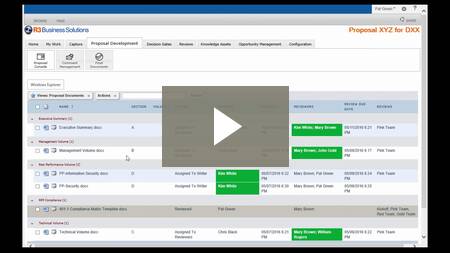Proposal development professionals working on RFPs typically have a very clear understanding of the process of work and what needs to get done. However, instead of being able to focus on the work that matters their days are cluttered (typically 30% at least) with dealing with all of the “noise” that surrounds the work. Noise is all of the administrative activity and manual work in support of the real work. It is distracting, unproductive, and provides lots of room for errors or things falling through the cracks.
In this article, we’ll look at the Work that Matters, the “noise” that surrounds the work and the costs, and, what you can do to eliminate it.
The Work That Matters
We know what we want to focus on. Here is a Top 10 list:
- Reviewing RFP and creating compliance matrix
- Holding Kickoff and Team Meetings
- Sourcing proposal templates, boilerplate and other proposal knowledge assets
- Tracking the schedule and making progress visible
- Assigning work to writers and reviewers
- Managing the “ping-pong” of work between writers and reviewers
- Making data calls internally and to teaming partners
- Conducting formal color review team sessions and recovery
- Reviewing comments and input to guide proposal work
- Managing compliance and production
When you look at your organizations’ process on paper it will include these items.
However, day-to-day reality for most proposal managers is actually very different.
The “Noise” of Proposal Development
Instead of being able to just focus on the above work, proposal managers typically spend about 1/3rd of their time each day dealing with the “noise” of work. Noise is all of the administrative activity and manual work in support of the real work. It is distracting, unproductive, invisible, and provides lots of room for errors or things falling through the cracks.
Below I list the Top 10 sources of Noise for most proposal managers and participants:
- Tracking assignments, work and information in spreadsheets
- Manually preparing status updates and reports
- Creating and managing multiple copies of documents
- Emailing documents and comments
- Guessing what you have to do now and next
- Hunting to find documents and information
- Recreating or fixing things that have already been done
- Having to pull important comments out of documents
- Manually moving documents around
- Using email for discussions that should be persistent and visible
For most proposal organizations, dealing with this “Noise” is just part of the job. But, it does not have to be.
The reason is really a result of technology. Most proposal shops still use document management systems for “proposal management”. They have gotten used to this document centric way of working over the last 10-15 years. This includes legacy, proprietary vendor systems like Privia, PMAPS and VPC and content management platforms such as Microsoft SharePoint.
Effectively, these systems are used to store and manage documents. Therefore, the people have to manually do lots of extra things to get work done. And, the way that work gets done generates more manual activity. The result is the “noise” which can overwhelm the work that matters.
A Better Way to Work
Imagine that you had a system that was designed to allow you to just focus on the work that matters. It would be designed to be work oriented vs. document centric. The documents and data were in the background.
What happens? The “noise” just goes away. Everyone is able to just focus on the work that matters. You get back 30% of your time. The distractions go away. Everyone knows where things are and what needs to be done. And, the issues that are really important become apparent and can be addressed in a timely manner.
You can make progress at eliminating the “noise” with incremental improvements or enhancements to the systems that you have in place. The above “noise” list gives you some clear targets to go after.
You can also just jump to a better place. Modern proposal management systems such as R3 WinCenter give you a better way of working without the “noise”. They are designed to do so. They are work management systems as opposed to document management systems. The focus is on enabling proposal managers to drive the work and manage it. They also make it easier for proposal participants to do their work using features such as co-authoring and in-line commenting. The work becomes streamlined and the noise just goes away.
Experience it for yourself in this 4 minute video. We’ll show you how to drive writer and reviewer work in a streamlined way using R3 WinCenter that effectively eliminates the manual work and the “noise”.


